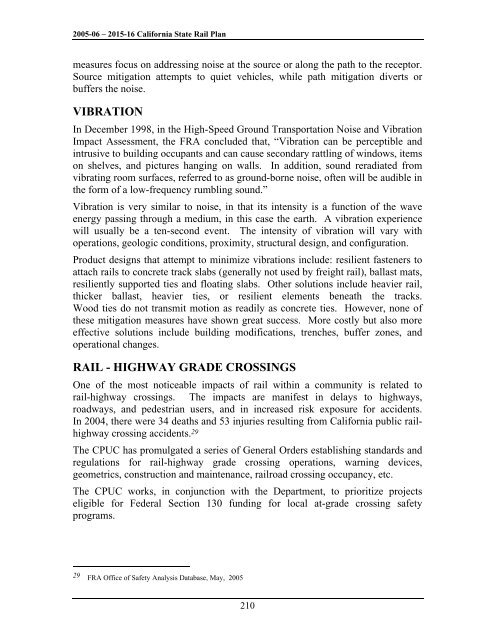California State Rail Plan 2005-06 to 2015-16
California State Rail Plan 2005-06 to 2015-16
California State Rail Plan 2005-06 to 2015-16
Create successful ePaper yourself
Turn your PDF publications into a flip-book with our unique Google optimized e-Paper software.
<strong>2005</strong>-<strong>06</strong> – <strong>2015</strong>-<strong>16</strong> <strong>California</strong> <strong>State</strong> <strong>Rail</strong> <strong>Plan</strong><br />
measures focus on addressing noise at the source or along the path <strong>to</strong> the recep<strong>to</strong>r.<br />
Source mitigation attempts <strong>to</strong> quiet vehicles, while path mitigation diverts or<br />
buffers the noise.<br />
VIBRATION<br />
In December 1998, in the High-Speed Ground Transportation Noise and Vibration<br />
Impact Assessment, the FRA concluded that, “Vibration can be perceptible and<br />
intrusive <strong>to</strong> building occupants and can cause secondary rattling of windows, items<br />
on shelves, and pictures hanging on walls. In addition, sound reradiated from<br />
vibrating room surfaces, referred <strong>to</strong> as ground-borne noise, often will be audible in<br />
the form of a low-frequency rumbling sound.”<br />
Vibration is very similar <strong>to</strong> noise, in that its intensity is a function of the wave<br />
energy passing through a medium, in this case the earth. A vibration experience<br />
will usually be a ten-second event. The intensity of vibration will vary with<br />
operations, geologic conditions, proximity, structural design, and configuration.<br />
Product designs that attempt <strong>to</strong> minimize vibrations include: resilient fasteners <strong>to</strong><br />
attach rails <strong>to</strong> concrete track slabs (generally not used by freight rail), ballast mats,<br />
resiliently supported ties and floating slabs. Other solutions include heavier rail,<br />
thicker ballast, heavier ties, or resilient elements beneath the tracks.<br />
Wood ties do not transmit motion as readily as concrete ties. However, none of<br />
these mitigation measures have shown great success. More costly but also more<br />
effective solutions include building modifications, trenches, buffer zones, and<br />
operational changes.<br />
RAIL - HIGHWAY GRADE CROSSINGS<br />
One of the most noticeable impacts of rail within a community is related <strong>to</strong><br />
rail-highway crossings. The impacts are manifest in delays <strong>to</strong> highways,<br />
roadways, and pedestrian users, and in increased risk exposure for accidents.<br />
In 2004, there were 34 deaths and 53 injuries resulting from <strong>California</strong> public railhighway<br />
crossing accidents. 29<br />
The CPUC has promulgated a series of General Orders establishing standards and<br />
regulations for rail-highway grade crossing operations, warning devices,<br />
geometrics, construction and maintenance, railroad crossing occupancy, etc.<br />
The CPUC works, in conjunction with the Department, <strong>to</strong> prioritize projects<br />
eligible for Federal Section 130 funding for local at-grade crossing safety<br />
programs.<br />
29 FRA Office of Safety Analysis Database, May, <strong>2005</strong><br />
210













